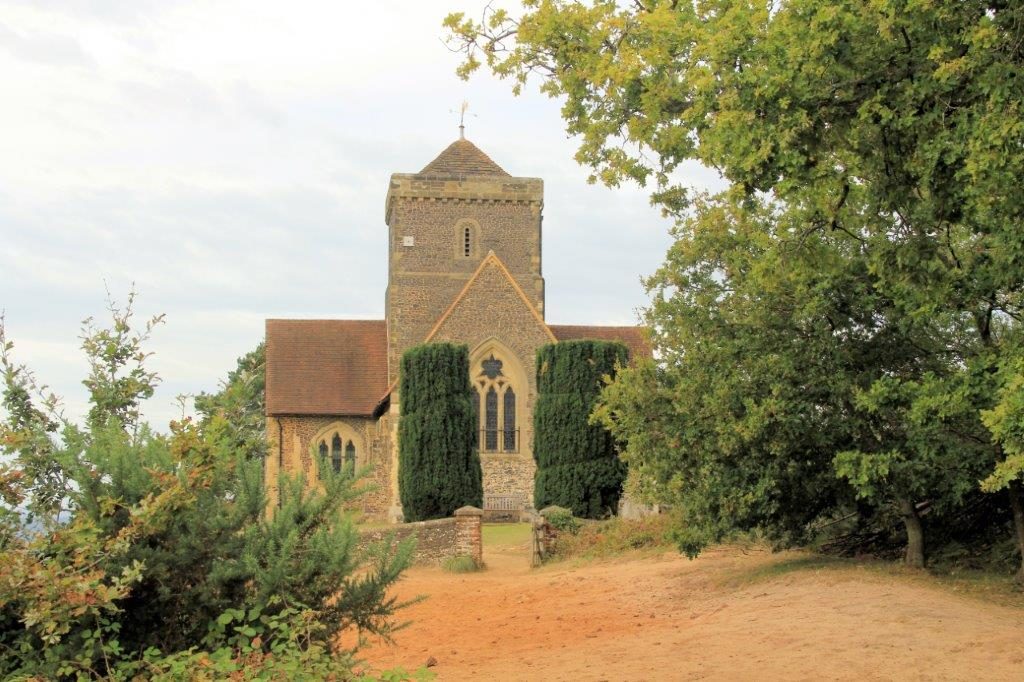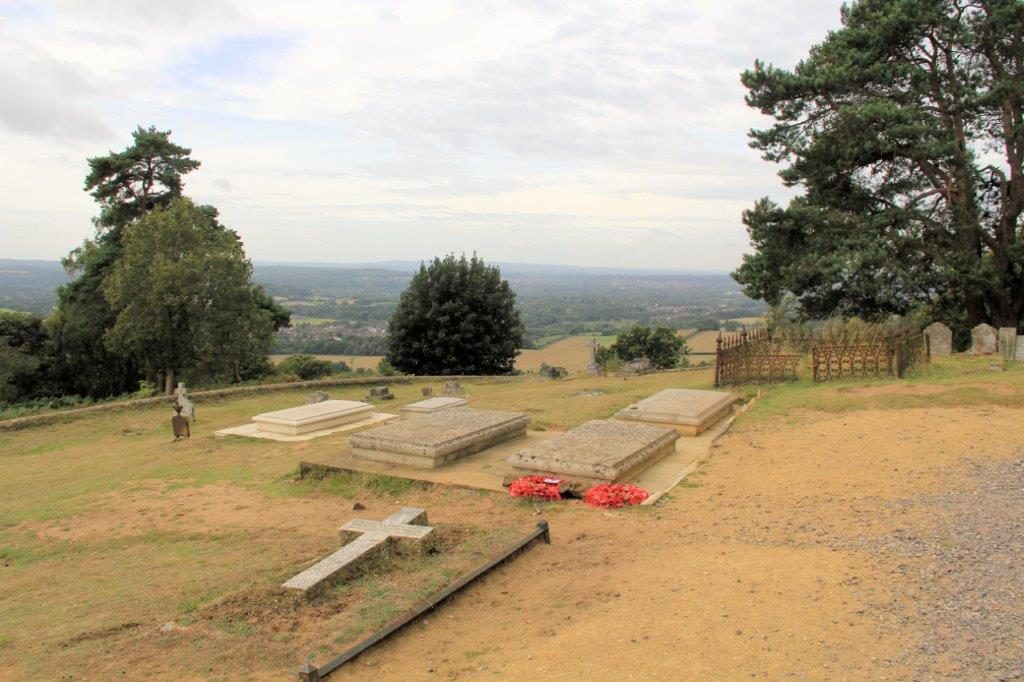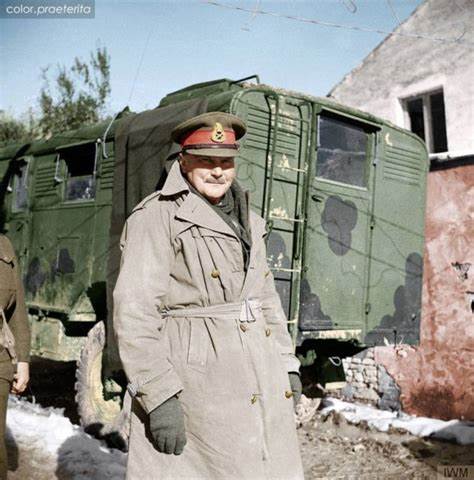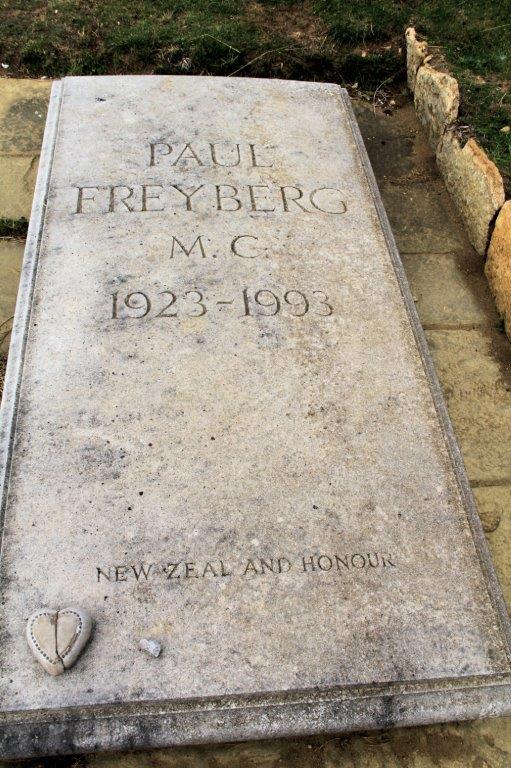Finding the Unexpected by Robin Hollamby
Finding the Unexpected.
On the way down to the reunion in September this year Vanessa and I stopped to have a look at an old church just to the south of Guildford. She had been running in the area the previous September and the route took in the footpaths around St Martha’s Church, which sits high on the Surrey hills. As we were so close I decided to stop and have a look.
This is a rural area and the church is a good ten minutes’ walk from the nearest car park, which is as close as you can get by car. After quite a steep climb up the sandy footpaths in the woodland the church sits atop of a hill in a clearing with wonderful panoramic views of the Surrey and Hampshire countryside.
Exploring an old country church and its churchyard can be interesting and a lovely way to spend some time on a fine early Autumn day. Unfortunately, the church like so many isolated churches was locked, although still in regular use.

Close to the porch was a group of four or five headstones all bearing the same family name, nothing unusual for a country church. There was, however, something familiar about it and a name I thought I had seen many times before. A quick check on the internet confirmed my suspicions. I was standing at the foot of the grave of one of the most popular leaders during the Italian Campaign that of Lieutenant General Bernard Freyberg leader of the New Zealand 2nd Division. Close by lays the grave of his wife Lady Freyberg another well respected woman, who played a very active part in helping look after the men of the New Zealand 2nd Division while in Egypt. Like her husband she was also very popular with the Kiwi’s.


Bernard was born on 21st March 1889 at Richmond, England, the family moving to New Zealand when he was 2 years old. He attended Wellington College and was a strong swimmer, winning the New Zealand 100-yard championships in 1906 and 1910. After qualifying as a dentist in 1911 he left New Zealand in March 1914 going to Mexico via San Francisco and became a Captain under Pancho Villa during the Mexican Revolution. Hearing of the start of the war in August 1914 he returned to the UK. Traveling via Los Angeles, where he won a swimming competition, and New York, where he won a prize fight earning enough to pay for the trip back to the UK.
Volunteering for service he joined the 7th ‘Hood’ Battalion of the Royal Naval Brigade and was sent to the Belgium front in September. Winston Churchill, on meeting him in late 1914, was persuaded to grant him a RNVR commission in the ‘Hood’ Battalion, part of the new RN Division. In late April 1915, during the invasion of the Dardanelles, he volunteered to swim ashore in the Gulf of Saros, where he lit flares along the beach distracting the Turkish forces from the real landings at Gallipoli. Despite coming under heavy enemy fire he returned safely receiving a DSO for his efforts. His division was evacuated from the peninsula in January 1916 even though he had received serious wounds on several occasions.
Transferred to the British Army in May 1916, as a Captain in the Queen’s (Royal West Surrey) Regiment, Freyburg remained with the ‘Hood’ Battalion as a second temporary major traveling with them to France. In the final stages on the Battle of the Somme, while commanding a battalion as a temporary Lieutenant Colonel, during the capture of the village of Beaucourt his actions were recognised with the awardof the Victoria Cross on 13th November 1916. Despite being wounded twice he remained in command; he held his position throughout the night until reinforcements arrived in the morning when he attacked the strongly fortified village taking 500 prisoners. Even though he was wounded twice more, the second time severely, he refused to leave until he had issued final instructions to his men. During his time on the Western Front he continued to lead by example and over the course of his time in France was wounded nine times.
In April 1917 he was again promoted to the rank of temporary Brigadier General (his permanent rank was still only Captain) taking command of 173rd (3/1st London) Brigade. At the time he was the youngest general officer in the British Army. Later in 1917 he was awarded a Companion of the Order of St Michael and St George. It was in September 1917 that he received the worst of his many wounds when a shell exploded at his feet. Resuming duty in January 1918, again in command of the 88th Brigade in the 29th Division, he performed with distinction during the German Spring Offensive of March – April 1918 for which he was awarded a bar to his DSO.
Freyburg finished his part in WW1 leading a cavalry squadron detached from 7th Dragoon Guards seizing a bridge at Lessins just one minute before the armistice came into effect, for which he was awarded his second bar to the DSO. At the end of the war Freyberg had also been awarded the French Criox de Guerre in addition to receiving five mentions in dispatches, which meant that he was with the VC and three DSOs ranked as one of the most highly decorated British Empire soldiers of the First World War.
The inter-war years saw Freyberg’s life change in many ways. Being granted a Regular Army commission in the Grenadier Guards during 1917 he settled into peacetime soldiering. He made attempts to swim the English Chanel and attended Staff College at Camberley. Between 1921 and 1925 he was at the headquarters of the 44th (Home Counties) Division as a staff officer. He visited New Zealand in 1921 as part of his convalescence while recovering from health problems, which had arisen as a result of his many wounds received during the war.
On 14th June 1922 he married Barbara McLaren, at St Martha on the Hill in Surrey. Barbara had two children from a previous marriage and a year later their son Paul was born. During the General Election he was an unsuccessful Liberal candidate for the seat of Cardiff South. He represented New Zealand as a member of the International Olympic Committee between 1928-1930.
During 1927 he had been promoted to the permanent rank of Major and held a GSO2 staff position at Headquarters, Eastern Command until being promoted to Lieutenant Colonel where he took command of 1st Battalion, Manchester Regiment. With a promotion to Colonel in 1931 he was appointed Assistant Quartermaster General of Southern Command. ‘A Study of Unit Administration’, which he wrote in 1933, quickly became the staff college textbook on quartermaster’s logistics and went into second edition in 1940. Given a GSO1 he was posted to the War Office in 1933, prior to being promoted to Major General in July of 1934. On the 16th October 1937 he was obliged to retire after a medical examination, prior to a posting to India, showed a heart problem. He had been made a Companion of the Order of the Bath in 1936.
Although still classified as unfit for active service he was returned to the active list after the outbreak of World War 2 in September 1939, as a specially employed Major General. Having been approached by the government of New Zealand, Freyburg offered his services to them and was given command of the 2nd New Zealand Expeditionary Force and the 2nd New Zealand Division.
In 1941 during the chaos of the retreat from the Battle of Greece, Freyburg was given command of the Allied forces during the Battle of Crete. Ignoring strong intelligence that an assault was coming by air he became obsessed with the unlikely possibility of a naval landing. Basing his tactics on this he failed to adequately defend the airfield at Malele.
Becoming a Knight Commander of the Order of the British Empire and promoted to Lieutenant General he continued to command the 2nd New Zealand Division through the North African and Italian Campaigns of the 8th Army. As a divisional level tactician, he had an excellent reputation, while Churchill described him as a ‘salamander’ for his love of fire and always wanting to be in the thick of the action. Despite being wounded by an exploding German shell during the Battle of Mersa in June 1942, he soon returned to the battlefield. He strongly disagreed with General Claude Auchinleck commander of the Eighth Army, insisting that as commander of a national contingent he had the right to refuse orders if he thought that they were not in New Zealand’s national interest. However, he had an extremely good relationship with General Bernard Montgomery, who was in command of the Eighth Army from August 1942, who thought highly of the very experienced New Zealand commander.
During the breakout of the Eighth Army at the Second Battle of El Alemein (October – November 1942) the 2nd New Zealand Division played a vital part. For his part in this Freyburg was promoted to Knight Commander of the Order of Bath. As the Axis forces were pursued to Tunisia, he led a number of outflanking manoeuvres on the Axis lines before they surrendered in May 1943. He briefly took command of X Corps during April and May 1943.
Following an aircraft accident Freyburg spent six weeks in hospital but returned to command the New Zealand Division in their final operations in the spring of the 1945 offensive in Italy. This involved a series of river crossings and advancing 250 miles in 21 days. Reaching Trieste by the time of the German surrender the New Zealanders had liberated both Padua and Venice. These exploits earned him the third bar to his DSO in July, in addition to being made a Commander of the Unites States Legion of Merit.
He had gained an excellent reputation in the planning of set-piece attacks; Operation Supercharge at Alamein, Operation Supercharge ll at Tebaga Gap, storming the Senio line in 1945 being some of the most notable. But at Crete and Cassino, where he was in command at Corps level, he was less successful. Always showing distain for danger, he had a notable concern for the welfare of his soldiers ensuring the establishment of social facilities for his men. He was also known for his common-sense approach to discipline. By the time he left his command in 1945 he was a very popular commander with the New Zealand soldiers.
Although associated with the very controversial bombing of the monastery at Monte Cassino during February 1944 Freyburg commanded the troops in what were later known as the Second and Third Battles of Monte Cassino. He had become convinced that the German forces were using the Abbey, which dates to 529 AD, as a military stronghold. Major General Francis Tucker of the 4th Indian Infantry Division had concluded the monastery should be destroyed regardless of whether it was being used by the Germans to prevent its occupation. General Sir Harold Alexander commander of the 15th Army Group agreed to the bombing, which later led to the occupation of the ruins by the German Army, who then held their position until 18th May 1944. Afterwards the abbot and other monks confirmed that the monastery had not being used for military purposes nor been occupied by the German forces during this period.

(Imperial War Museum image)
Giving up the command of the New Zealand Division Freyburg took up the invitation to become Governor General of New Zealand in November 1945; he was the first to hold the post with a New Zealand upbringing. On 3rd May 1946 after being made a Knight Grand Cross of the Order of St Michael and St George he left London to take up his new post, a position he held until 1952. During his time as Governor General he visited all parts of New Zealand and its dependencies. On 1st January 1946 he was appointed a Knight of the Order of St John with his wife Barbara appointed a Dame of the same order.
During 1951 King George VI raised Freyburg to the peerage as Baron Freyberg of Wellington in New Zealand and of Munstead in the County of Surrey. On completion of his term as New Zealand’s Governor General he returned to England sitting frequently in the House of Lords. After being appointed Deputy Constable and Lieutenant Governor of Windsor Castle he moved into the Norman Gateway of the castle in 1953.
Bernard Freyberg died on 4th July 1963 at Windsor after one of his many war wounds had ruptured. He and his wife were buried in the churchyard of St Martha’s with the grave of their son Paul, who in 1943 had been awarded the Military Cross during World War II, at their feet.

Robin Hollamby. National Vice – Chairman

Just to mention that the photo of Freyberg in Italy has been colourised from monochrome. Here’s a quote from the colouriser’s Facebook page:
//////-
About
Hi, I’m Harry and I’ve created this page to showcase my efforts in colouring old black/white photographs. Just for fun!
/////-
Though I do some of that myself, I feel we should Always know in these days when ‘tech’ can do so much with reality..
Ie: https://www.facebook.com/pg/color.praeterita/about/?ref=page_internal